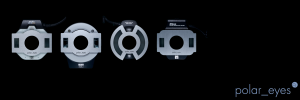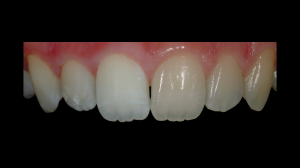Do you struggle with taking accurate shades for challenging anterior cosmetic dentistry cases, such as large composite resins or porcelain crowns? Like most of you, I’ve always considered this one of the hardest aspects of dentistry, even with the power of digital photography. Now, however, a new tool has arrived that promises to revolutionize and simplify this challenge. It’s easy to use, affordable, and the most powerful tool for analyzing and communicating hue, value, and chroma in our dental restorations that I have ever used.
The polar_eyes Cross-Polarizing Filter
 I first learned about this revolutionary new filter design on Facebook from Dr. Jason Smithson, whose composite resin artistry easily rivals that of the best lab technicians. Designed by Dr. Panaghiotis Bazos, a Greek dentist trained at the University of Southern California (Class of 2000), this filter is easily attached to Canon, Nikon, Sigma, and Metz ring flashes.
I first learned about this revolutionary new filter design on Facebook from Dr. Jason Smithson, whose composite resin artistry easily rivals that of the best lab technicians. Designed by Dr. Panaghiotis Bazos, a Greek dentist trained at the University of Southern California (Class of 2000), this filter is easily attached to Canon, Nikon, Sigma, and Metz ring flashes.
Color is Complicated
Just recently, Dr. Lane Ochi posted an Online CE Course on DentalTown.com that uses Color Theory to teach how we perceive color, and while I had learned some of this earlier, he gives the most thorough description I’ve seen – highly recommended. Fair warning – you’ll probably want to review it several times to really absorb the material, because he packs a LOT into that 1-hour course.
In simple terms, however, one of the biggest challenges we face when taking shades for cosmetic dentistry, whether porcelain or composite, is the reflection of light from the teeth, whether that reflection comes from overhead lights, ceiling lights, or the camera flash. The human eye has difficulty dealing with how that reflection can hide details of color. And given that most of us aren’t trained in truly understanding color, even if we can see it, how do we communicate it to the lab? For years, dentists have used different kinds of shade-matching devices, but based on many reviews, none of them have been particularly easy to use, and most of them are expensive.
Eliminate the Glare, and What’s Left is Color and Brightness
 Take a look at this example photo (courtesy of Dr. Bazos), and what do you see? On the right side of the photo is what we typically see in DSLR photos taken with a ring flash, and on the left side is how teeth look when photographed using the same exact settings and the polar_eyes cross-polarizing filter. The difference is striking and easy to understand.
Take a look at this example photo (courtesy of Dr. Bazos), and what do you see? On the right side of the photo is what we typically see in DSLR photos taken with a ring flash, and on the left side is how teeth look when photographed using the same exact settings and the polar_eyes cross-polarizing filter. The difference is striking and easy to understand.
Since this blog is dedicated to making dental photography easy-to-understand, at this time, I am not going to discuss what exactly cross-polarization is, because it’s not really necessary to understand it to use this cool little device. Perhaps at a later date.
The polar_eyes is incredibly easy to install, but it’s a little tricky to keep in place for Canon flashes due to the flash design (not the filter design). Attached by a set of stick-on magnets, it is easily set up on your flash in about 2 minutes (if you’re really slow at reading the directions). Press the sticky side of the magnets to a clean flash surface, and you’re good to go! The filter is removed by gently sliding the filter up for down – you don’t want to pull it off, as the magnets can pull off, too. Don’t ask me how I know, ok? 😉
Where to Buy the polar_eyes?
Dr. Bazos has made the polar_eyes exclusively available through www.Photomed.net in the USA. Outside the USA, you will need to contact Dr. Bazos directly.
Cost: This is the absolute best part – it’s only $499! Extra sets of magnets (highly recommended by me to be on the safe side) will be a bit more, but as of the time I purchased mine, the price for them had not yet been determined. But compared to almost any other system currently available, this is super-affordable and amazingly easy to use. Literally, the first time you take a photo with it and look, you will love it.
More details and tutorials will be upcoming, so be on the lookout.
Only 499 ?? Are you kidding me ?? Polar filter costs 3 dolars !!! 😀
Have you ever created a polar filter that fits ring flashes and designed it for mass production, marketing, shipping (international), some profit for the designer, some profit for the seller……..
But hey, if you can do all of that and make a product that dentists anywhere can simply snap onto some magnets on their flashes without permanently damaging them for only $3, more power to you! Let me know when you have it ready for market, send me one, and I’ll review it for you.
Otherwise, keep the peanut gallery comments to a minimum, please.
Absolutely! I use it ALL the time on anterior composites, crowns, bridges, anything where shade is crucial and I need to communicate it. I haven’t had to send a single case back for the shade to be tweaked since getting it. Of course, working with Al Hodges and already sending him a lot of photos, that didn’t happen often anyway, but now it NEVER happens.
Thanks for sharing ! This info is useful for me !
Hi polar_eyes users,
can you provide the flash and camera settings you use for best performance. I use it on a canon DSLR with the Canon ring flash and a 100mm Canon macro lens.
Thanks
Andreas
Just ordered mine. Photomed is including an extra set of magnets with your order.
That’s great to hear, Michael. When I ordered mine, they hadn’t received the extra sets yet, so I will be getting some extras soon. Be sure to check back and let us know what you think after trying it out a bit.
Arghh. Like the product. The mounting system needs to be redone. I place the magnets on, used the polar eyes to take some shade pictures. Worked great. I had another patient in the day that I wanted to get pictures of his red inflamed calculus covered teeth. I did the “rotate” the filter off and all the magnets came off. I wish they had a different mounting system. Did not even make it one day with the magnets/adhesive failing.
Michael, I think it’s really important to clean the flash surface REALLY well, then make sure to press and hold the magnets on firmly for quite some time, probably even let it just stay on for an extended period before removing it. And you have to slide it off.
From my first set, 2 of the magnets stuck really well and are still in place, and since one is top left and the other lower right, they hold the polar_eyes in place well enough to work. I’m awaiting the spare set they’ve sent and may even try a little super-glue. I’ll let you know how it goes next week.
Not sure how else it could be mounted, though, as any other method would require damaging the flash itself.
The other issue with the Canon version, and I’ve discussed this with Panos, is that it gets knocked off when you set the camera down. Unfortunately, if he flattened it, light could leak around the edges and screw up the effect, so it’s a design compromise required by the flash design.